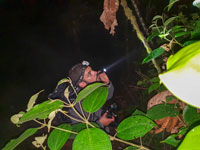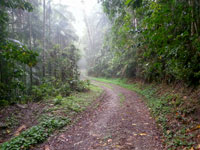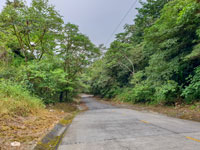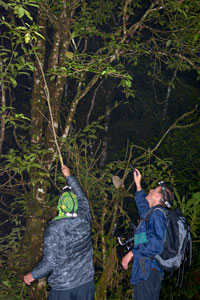This technique consists in to take the phasmids by hand, one by one. It is the commonest technique.

Basic equipment needed:
- Water-proof headlamp and batteries. Additional hand lamp with batteries.
- Plastic boxes and zip bags.
- Butterfly net.
- Camera and macro equipment (lens and flash). Batteries.
- GPS or smartphone with an App to take coordinates.
Summary of the workflow for this method:
- Explore the area during the daytime to be more familiar with it.
- Start searching phasmids after sunset.
- When finding a phasmid, take pictures and coordinates.
- Collect the phasmid, some leaves of the plant where it was (especially if was feeding on it) and put them carefully in the plastic container.
Detailed information:
For applying this collecting technique a light-weight and water-proof head torch or headlamp (e.g. Petzl Megabelt) including several batteries for change are required; the number of batteries carried with you should ensure the lamp to work for at least 8 hours. The advantage of using a head torch instead of ordinary hand lamps is, that the light is always where you’re looking at and both hands are free to handle caught insects or taking photographs. However, an additional strong hand lamp (e.g. Maglite) should be carried along, in the rucksack or fixed to the collector’s belt to ensure it cannot get lost during a fall. In one's rucksack, there should be different sized plastic containers or plastic bags with air holes in the lid as well as a butterfly net and extendable handle.
It is of advantage to investigate and mark the sites which are planned to be collected at night already during the daytime. This allows you to get an overview of the surroundings, vegetation and possible areas of danger. Should you plan to collect at or in private properties you need to talk to the owner first, in order to avoid any misunderstandings. Please keep in mind that you might easily look like a criminal or burglar to people (or dogs!) who do not know what you are doing on their properties at night, wearing a hand- or head torch and rucksack!
Searching along forest borders, roads, wide paths, riverbanks, around clearings caused by fallen trees or rocky outcrops appear to be the most prolific habitats for this collecting method, as in all of the mentioned areas there will be enough vegetation close to ground level. Carefully searching a stretch of 200 meters can easily take up to an hour or more, but patience and thoroughness are worthwhile in most cases! Furthermore, mountainous regions have proven to be very prolific and do usually possess a very high rate of biodiversity. For many species, the presence of human settlements does not seem to be of importance and large numbers of phasmids can even be found in the direct surroundings of villages and smaller towns, in agricultural areas or even gardens and public parks.

The selection of prolific collecting sites requires some experience but can be summarized as follows: Forest border or wide path / road with a width of at least 2 meters, which is fenced with rich low-growing vegetation (secondary forest), if possible damp, shady, slightly protected from wind, at least 100 meters off the coast and eventually close to rivers, lakes or at river banks as well as mountainous regions. “But exceptions confirm the rules” - everyone should try for him- or herself!
When using this method, most phasmids are usually found on low growing vegetation and smaller trees between 0.5-5 meters off the ground. Hence, species that live in the canopy blocks remain inaccessible to the collector.
In general, searching for stick-insects at night is much more worthwhile and productive than looking for them during the daytime. The true fullness of biodiversity in a habitat is usually only seen at night and stick-insects seem to hide deeper in the vegetation at daytime and are often camouflaged that well, that they are completely overseen even by the experienced eye. We should not forget that they are the real masters of camouflage. As an example: At one collecting site in Borneo (Sarawak) we were able to locate only 5 specimens at daytime but 92 in the same night! The most prolific time seems to be shortly after dawn until 23:00, while females usually appear later during the evening than males. If there was rain in the late afternoon and the vegetation is still wet until darkness arises or with rainfalls during the night the number of specimens located my rise frequently. This is especially the case in tropical regions and concerns to other Orthoptera (e.g. Ensifera, Caelifera) as well.

If one has found a phasmid, it is wise to take some photographs of the specimen in its natural environment and on its native food plant, before catching it. When handling the insect, you need to be careful, as phasmids can be very active and move quickly, in contrast to their lethargic behaviour in the daytime. The insect should be seized at the thorax and at best with only two fingers if the specimen is very delicate (never seized from legs, they can easily be detached by autotomy). Afterwards, the insect should be placed in a plastic box or plastic bottle with a sample of the plant on which they were found. In addition, to know its native food plant, this gives the insect something to hold on. Rather than use a bottle, plastic bags may be used which need to be inflated before being sealed. These can then be attached to the belt of the collector or placed in a rucksack. Very fragile species are better stored in stable plastic boxes or bottles rather than being left in plastic bags. Extremely large species can be placed in large plastic or rubbish bags. Well flying species are at best caught using a wide butterfly-net. Females of unfamiliar species should be kept in individual containers, to ensure that eggs laid are recognized and correctly assigned. Mating pairs are kept at best kept apart from other phasmids.
Whenever a feeding phasmid has been located, it is of importance to keep the plant it was found on in mind, as this is a potential native food plant of the species found and more specimens might be located if this kind of plants are searched more carefully. Generally, it is of advantage to have a knowledge of the preferred food plants of the different phasmid species and if the insects are wished to be kept alive in order to rear them, fresh cuttings of the food plants should be done at once which can then be offered as food. Furthermore, detailed pictures (the entire plant, the stems, leaves, flowers, fruits, etc.) should be taken in order to identify them at home. A high percentage of phasmids are polyphagous and thus quite widely distributed, while more specialized feeders (predominantly flying species) are generally distributed more locally and may often be found in large colonies.

If a specimen is found on a tree in heights of more than 5 meters (often the case with larger species, e.g. Pharnacia, Acrophylla, Ctenomorphodes) and the extendable handle of your net is still too short, there is a little trick which has proven to be quite successful: First you search for a long broken branch in the ground (of course longer than the extendible handle of your butterfly net – there should be plenty in a tropical forest!), which is then used to make the insect move to lower regions or even catching it if possible. The branch is carefully moved beneath the insect’s body and between the insect and the leaf or branch it rests on. By slightly shaking the leaf or branch used for resting, the insect will start moving and in most cases use the collector’s branch to find a stable possibility to recline. If the insect has done so (in some cases you need to be really patient!) the branch can be carefully and slowly moved towards the ground. In order to catch the specimen. This little trick is however only sufficient with relatively large and non-flying insects, as the small and well-flying species will directly fly off as soon as the leaf they rest on is moved. For catching the latter species, collecting method No. II is more suitable and successful.
It may be said, that by applying this collecting method, phasmids will appear to be some of the most common and striking orthopteroids in a tropical biotope. Pest-like, local occurrence of single species may even cause strong defoliation. Apart from Phasmatodea, the described collecting method has also proven to be quite sufficient for other orthopteroids (e.g. Orthoptera, Mantodea, Blattodea), insect orders like Heteroptera or Formicidae as well as other various arthropods (e.g. tree-living arachnids or scorpions).
{"preview_thumbnail":"/sites/default/files/styles/video_embed_wysiwyg_preview/public/video_thumbnails/sw05r5OvQ-4.jpg?itok=LQvy5aH7","video_url":"https://www.youtube.com/watch?v=sw05r5OvQ-4","settings":{"responsive":1,"width":"854","height":"480","autoplay":0},"settings_summary":["Embedded Video (Responsive)."]}